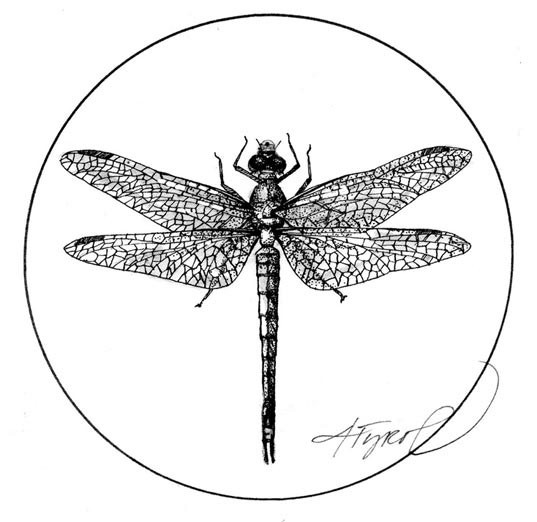
During the heat of mid-summer, when birds are often quiet and well-hidden, I turn my attention to dragonflies. Because they are sturdy bodied insects with wings that are not easily damaged (unlike butterflies), it is safe to capture dragonflies in an insect net to observe them in the hand and later release them unharmed. It’s safe, but not especially easy. I caught my first dragonfly a few years ago on the first swing of my net. It took me more than 40 swings to catch my next one, and it was more than a year and hundreds of swings before I caught my first common green darner. I think I have only caught one other since then.
Common green darners, one of the largest dragonflies in the region, range across the entire United States and southern Canada. They fly back and forth along the edges of ponds and fields like military helicopters patrolling a war zone, snatching soft-bodied insects from the air and devouring them on the wing.
They are stunningly beautiful. Their green head and thorax and three-inch, bright blue abdomen (reddish in females) make them instantly recognizable in a wide variety of habitats. Yet many people are afraid of them, having heard the myths that dragonflies will sew your lips together or sting. They do neither. And while the jaws of green darners are large and powerful by insect standards, they are not strong enough to break through even one layer of human skin.
Like all dragonflies, common green darners are aquatic insects for most of their lives. Their life cycle begins with a tandem egg laying flight that is unique among darners. At the end of the male’s long abdomen is a pair of “claspers,” which are used to grasp the female during mating. The couple remains connected until the female deposits her eggs. She does this by submerging her abdomen beneath the water’s surface, and depositing her eggs on the stems of aquatic plants. The eggs hatch, and the larvae live in the water as carnivorous nymphs for two or more years before crawling up at night and transforming into adult dragonflies. In the water the larvae swim by jet propulsion, squirting water out the end of their abdomen.
In the air from June to September, adults fly on strong, veined wings. Like most dragonflies, they can fly frontwards, backwards, and upside down. In late August and September, they travel up to 60 miles a day as they venture southward to avoid the approaching cold weather, sometimes traveling in massive swarms. The offspring of these migrants make the return one-way trip north in succeeding years.
I caught my second green darner at the edge of a popular fishing hole, a place where I was somewhat self-conscious among the fishermen as I swung my net again and again. I’m sure I looked silly, but I did my best to focus on the dragonfly without making eye contact with those watching my antics. It didn’t add to my dignity when my quarry alit on my head and shoulders and, occasionally, on my net. But that’s part of the fun.
I finally caught the dragonfly and held its wings together over its back to remove it from the net. Its legs struggled to grasp my fingers and shirt, and its abdomen curled up and down in an effort to escape. Eventually it settled down and allowed close examination. That’s when I first noticed that common green darners have a bulls-eye pattern on their forehead and their wings appear to have an amber tinge to their leading edge.
After taking a moment to enjoy the color and physiology of the dinosaur-like dragonfly, I placed the darner on my hand and released it. It lingered there for a moment. After a few seconds, it appeared to shrug its shoulders and disappeared over the pond, ready to taunt me again on my next visit.


Discussion *